It's a cold, windy morning in mid-January 2022, and I’m standing at a tram stop beside the Vltava river in central Prague. I shuffle my feet to stay warm as I wait to meet up with Dr Prokop Tomek of Prague’s Institute of Military History. It was Dr Tomek who had first succeeded in locating my StB surveillance file and sent me that surprising email over the Christmas holidays I wrote about last week. He’s kindly agreed to accompany me to the archive so that I can view the file for myself. The archive occupies a nondescript building (see map plot, below), a few meters from the tram stop. I’d walked past the building hundreds of times over the years without ever noticing it.
The archive opens on schedule at 9am, and Dr Tomek ushers me inside. Our first stop is the reception window – the vrátnice – where I show my Czech residency visa and receive a locker key in return. In hushed tones, Dr Tomek gives me a short lesson in archive etiquette. He tells me I won’t be allowed to bring into the main reading room my coat or any other personal effects. Thankfully, though, I can bring in my phone – and its built-in camera.
The reading room resembles a small library. Here and there, a few scattered individuals hunch over their desks and read through pages of yellowing paper. They study the materials carefully and then, occasionally, rise from their chairs to train their cameras on them and snap a photo. I wonder to myself if anyone here now, like me, is reading their file for the first time.
Dr Tomek and I find a table toward the back of the room. I sit down and try to make myself comfortable, while he goes over to a counter to fetch my file from an archive researcher. I’m nervous. Aside from the sketchy details I learned from Dr Tomek’s email, I have no idea what to expect. My mind drifts and then I hear Dr Tomek walk up behind me. He plops down a stack of dusty, blue booklets that, at first glance, looks exactly like the books we used in college for taking exams. “Here,” he says, “is your file.”
Meeting My Alter-Ego
The name on the booklet identifies the contents as belonging to “Objekt: INTER.” It takes me a moment to grasp that the object in question, INTER, is me. Indeed, I’m referred to everywhere by this peculiar name. INTER was the code name the StB assigned to me and, most-probably, a shorthand reference to the company I worked for: Business International. It could also have referred to the hotel the authorities often wanted me to use whenever I came to Prague (and which turns up frequently in the files as well): the Hotel Intercontinental.
As I page through the booklets, I notice the StB wasn’t always very creative in assigning their code names. I see the name they gave Arnold, my BI stringer (who I discovered years later was a paid StB informant), was simply “ARNOL.” It wasn’t exactly effective cover.
As it turns out, the blue booklets constitute only a small part of my file. The booklets mostly pertain to a single StB operation: a day-long effort to surveil my movements on the date of June 29, 1989, while I was in Czechoslovakia on a reporting trip. I am initially puzzled by the choice of this date, about which I can’t recall one significant detail. Later on, after I’ve had the chance to read through the file, the logic of that date becomes clearer. I’ll write more in future posts about how shockingly detailed this surveillance effort was and the likely significance of the June 1989 date.
After paging through the blue booklets for an hour or so, Dr Tomek motions me over to the counter, where an archive researcher hands me a USB flash-drive with hundreds of additional pages. These are mostly digitized photographs of materials relating to a larger, covert Czechoslovak espionage scheme called “Operation OHEŇ” (Operation FIRE in English). The name means nothing to me, though I later learn that OHEŇ was a secret plan to infiltrate offices and organizations around Europe affiliated with the United States. These included American embassies and consulates as well as companies, banks and media groups. According to OHEŇ, Vienna was an important target city, and I was apparently being primed to function as one of the operation’s witting (or unwitting) accomplices.
I scroll through the contents of the flash-drive on the archive’s computer and struggle to make sense of what I’m reading. The Czech language is unusually dense. The pages are filled with cryptic abbreviations and code names (that are much harder to tease out than the laughable “ARNOL”). Indeed, the identities of just about everyone mentioned in the materials, whether they were employees of the secret police, informants, or merely targeted “objects” like me, are hidden behind code names. I struggle to think of who individuals with names like “TOUFAL,” “BARGER” or “RIGA” might be in real life. I desperately hope the names aren’t masking the identities of former acquaintances or even old friends.
While clicking through my file, I occasionally come across index pages affiliated with "INTER" with lists of items that are crossed out. Dr Tomek tells me this means the materials were once part of my file but were lost in the years since 1989. It dawns on me that my file was at one time much larger than what I see now. Not only are many pages missing, but the materials that refer directly to me only start to appear in mid-1988, around the time I took part in a month-long Czech-language course in Brno. There’s almost nothing about me from before then -- even though I began working at BI (and traveling to Czechoslovakia) two years earlier, in 1986.
After a couple of hours of reading and snapping photos, I reach the limit to what I can absorb. I’ll need the help of a professional translator to fully comprehend the documents. I put the flash-drive in my pocket and say farewell to Dr Tomek and the archive staff. I fetch my belongings from the locker and exit the building. I have some reading ahead of me.
Learning the Lingo of the StB
Over the next few weeks, with the aid of a professional translator, I poured over the contents of my file. The first priority was to try to make sense of the bewildering abbreviations the StB used in its internal communications.
Here’s what I learned: I was under the surveillance of “Section 37” of the first directorate of the Czechoslovak Security Services. Section 37 was an important branch of Czechoslovakia's foreign intelligence. Its main focus was to carry out operations in German-speaking countries, including the Federal Republic of Germany (West Germany) and Austria. It operated primarily through resident stations based in the West German capital, Bonn, as well as Frankfurt am Main, West Berlin, The Hague and, of course, Vienna (where I lived at the time).
Each individual named in my file, either by the person's real name or more commonly a code name, was preceded by an abbreviation meant to convey that person’s status -- in other words, whether he or she was employed by the security services or functioned as an independent informant or collaborator. Individuals who worked directly for the StB were typically labelled as “KP” (cadre member), “OP” (operations officer) or “ŘO” (case officer). The main categories for collaborators included: “A” (agent), “TS” (secret collaborator) and “IS” (ideological collaborator). Arnold’s code name, for example, was usually preceded by “TS” (as in “TS ARNOL”). This indicated he was a paid collaborator (and not a formal employee of the secret police).
Similarly, prospective targets, like me, were assigned abbreviations to convey their status. Individuals at the start of the process – people who had been identified for possible collaboration but not yet vetted, were labelled as “RS” (elaborated contact). An abbreviation of “RT” indicated a more-advanced form of involvement. A person labelled with “RT,” for example, would already have been surveilled and primed for an approach. My own file is not always clear as to what my status was. I started out as “RS,” but according to a page in my file, by May 1989 I had been elevated to “RT.” My name, INTER, frequently appears in the file with no abbreviation at all or preceded by the word “Akce" (“Operation”). I later learned that "Operation INTER” was the name of the special espionage operation the StB assembled to spy on me and recruit me.
Organizing My File Into Sections
Once I nailed down the terminology and abbreviations, the materials made more sense. I discovered that my file – or rather what survived of it – could be divided into half a dozen main sections, starting chronologically from the middle of 1988 and running to November 1989. (I’ll briefly outline here these sections and go more deeply into the contents in future posts).
The earliest documents that pertained directly to me dated back to August 1988 and my participation in the month-long Czech-language course in Brno. I can’t say with 100% certainty, but this appeared to be the first time I popped up on the StB’s radar screen as a person of interest. (As a quick aside: in my book, "Čas proměn," I wrote – ironically in retrospect -- that while attending this course, I felt for the first time during many trips to Czechoslovakia to be free of any external surveillance.)
The next grouping of materials dated from early 1989 and included instructions from the StB’s resident in Vienna to the Czechoslovak Embassy there to report on any occasion I applied for a visa to travel to Czechoslovakia (apparently they wanted a heads-up on any trips I might take).
There’s a flurry of documents that appeared around April/May 1989. These included what’s referred to as a “memorandum,” indicating that the StB planned to recruit me as a possible agent. Attached to the memorandum was an amateurish, painful-to-read psychological assessment of me (part of which I summarized at the start of last week’s post). The point of the assessment, presumably, was to identify any traits they could exploit. To this day, I have no idea how or where they got this psychological report.
Fast forward a few weeks later, to June 1989, the next batch of materials related to the day-long surveillance operation on June 29, 1989, so tidily documented in those dusty blue books Dr Tomek had retrieved for me. Around this time, too, according to my file, there was an odd request by the Czechoslovak intelligence services to their colleagues at the Soviet KGB to ask if my company, Business International, was in any way affiliated with American intelligence. I couldn’t find an answer to that question. Either they never got a response or it was deleted at some point from my file.
After a gap of four months, the next set of documents in my file pertained to a reporting trip in early-November 1989 I took to Prague and Bratislava. According to the materials, this trip marked the formal start of "Operation INTER." The goal of my trip, which came just days before the fall of the Berlin Wall and the start of Czechoslovakia's Velvet Revolution, had been to report on whether the anticommunist demonstrations underway in East Germany might spill over into Czechoslovakia. According to the documents, the StB appeared to be mostly oblivious to these massive, historic events – even though the end of Czechoslovakia’s own communist regime was only a couple weeks away. My file, instead, included highly detailed surveillance reports on my stay at Prague’s Hotel Paříž and some salacious details of the operation the secret police had cooked up for the final, Bratislava leg of the trip. More on that in future posts.
The last chunk of materials in my file, by far the largest, appeared initially to have no connection to me whatsoever. This section included hundreds of documents going back to the 1970s and ‘80s on Austrian and European politicians who had long ago exited the stage. How my name ever got tied up in any of this, I didn't have a clue. I later learned this was background material for a larger StB scheme called “Operation OHEŇ.” After connecting the dots, it all began to come together.
(In Part 3, I write more about my file, including details about "Operation OHEŇ," the Czechoslovak espionage scheme I was being primed for. Click here to go directly to Part 3. To go back to Part 1, click here.)

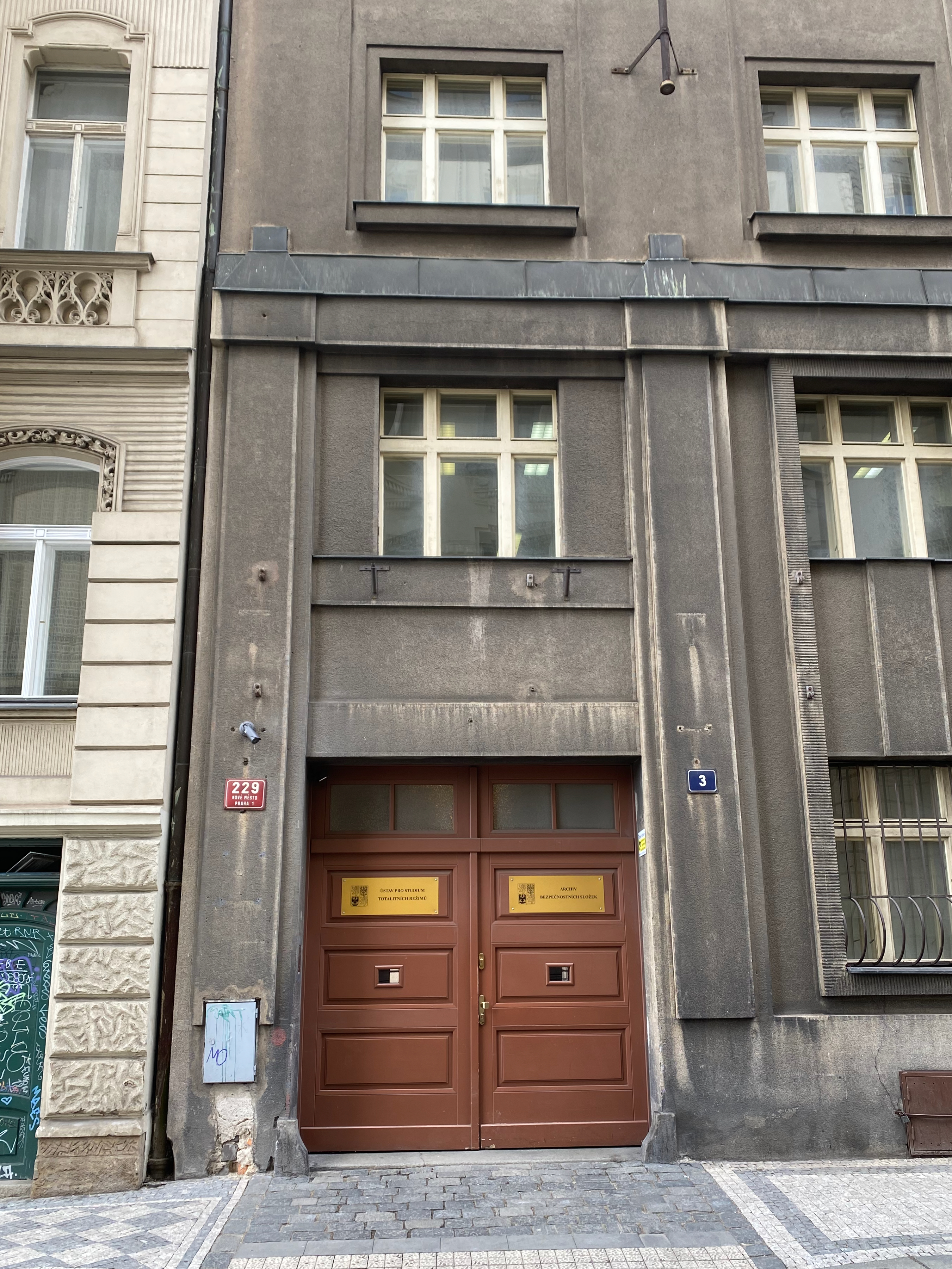

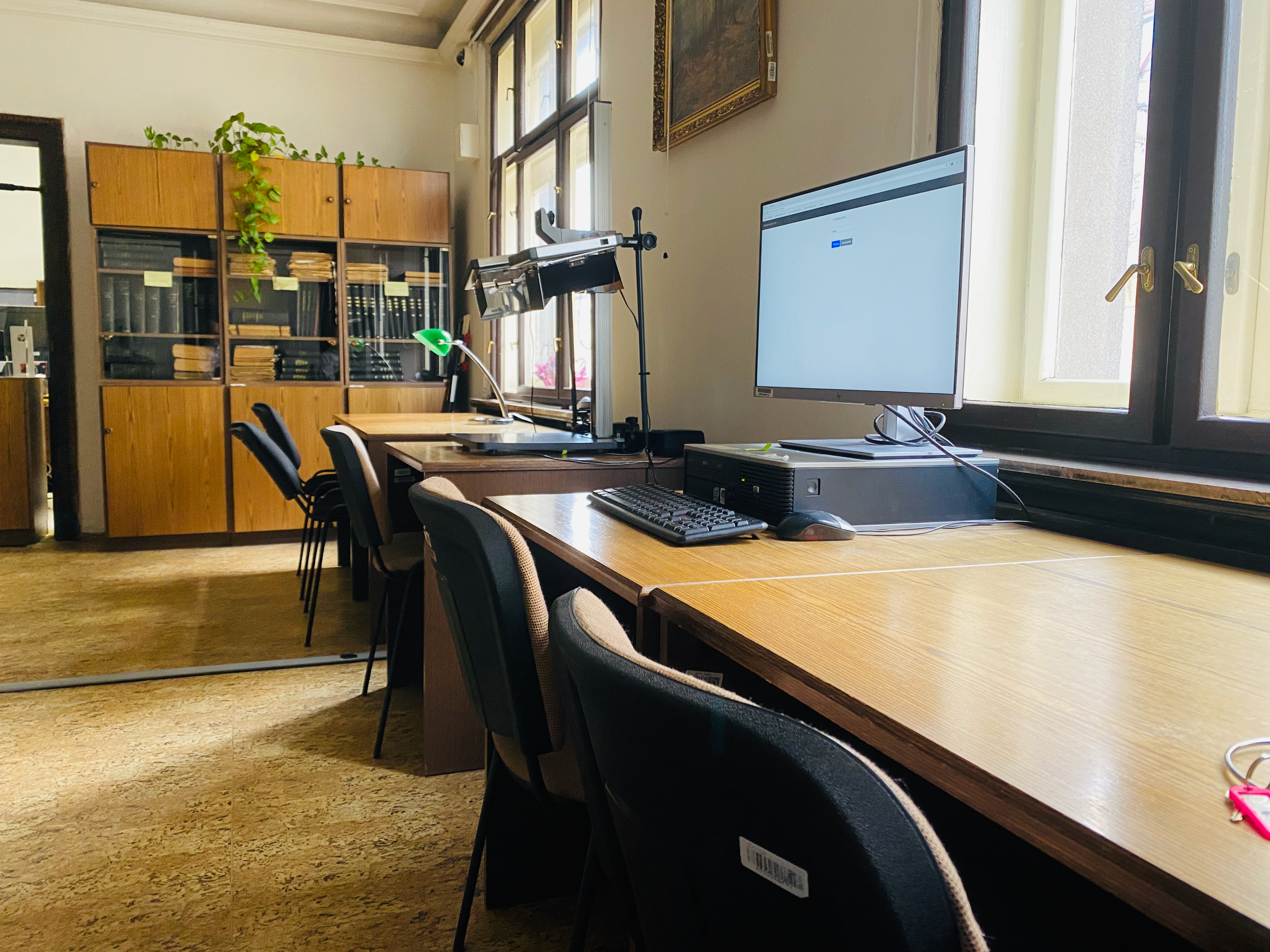

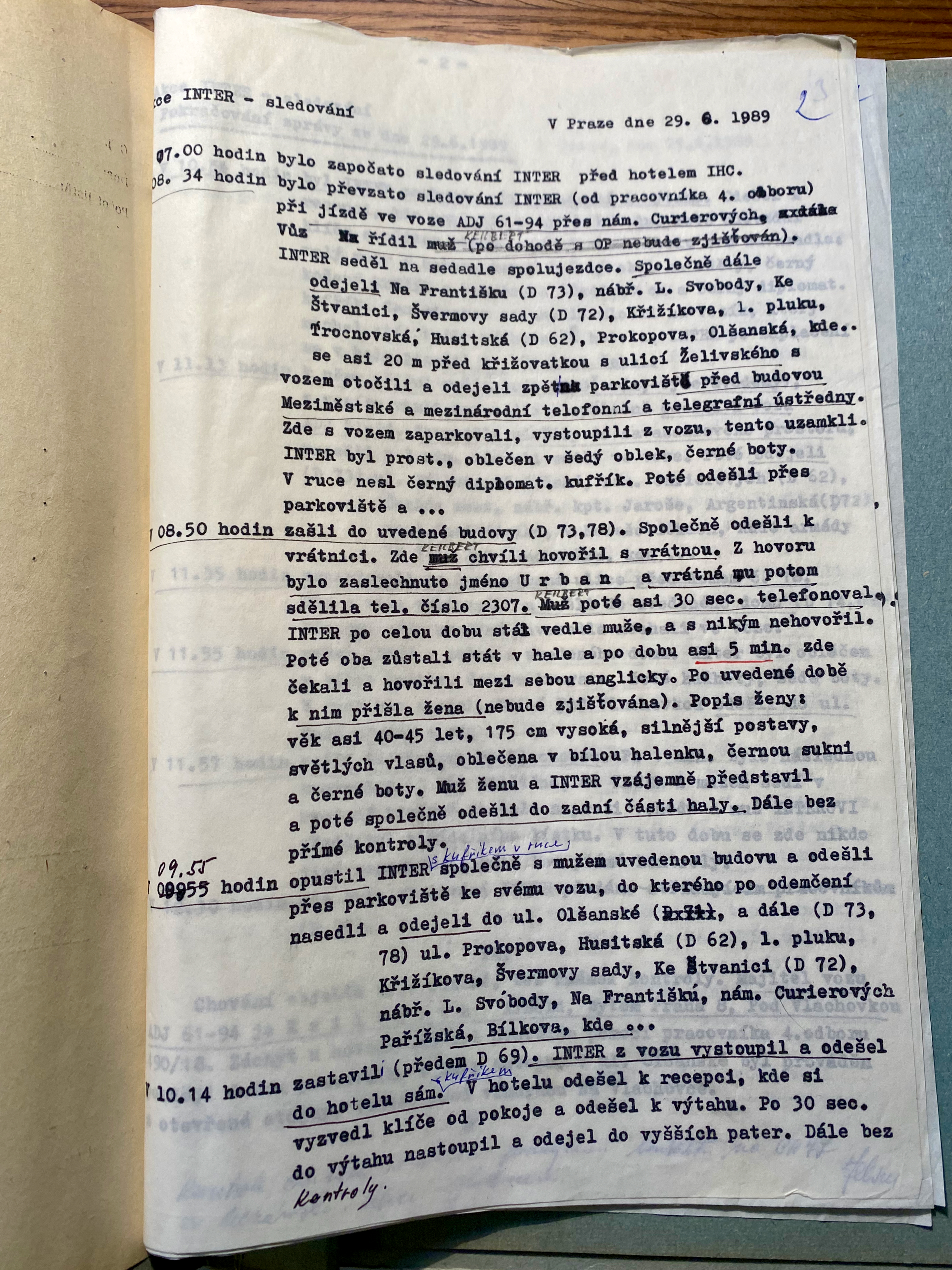
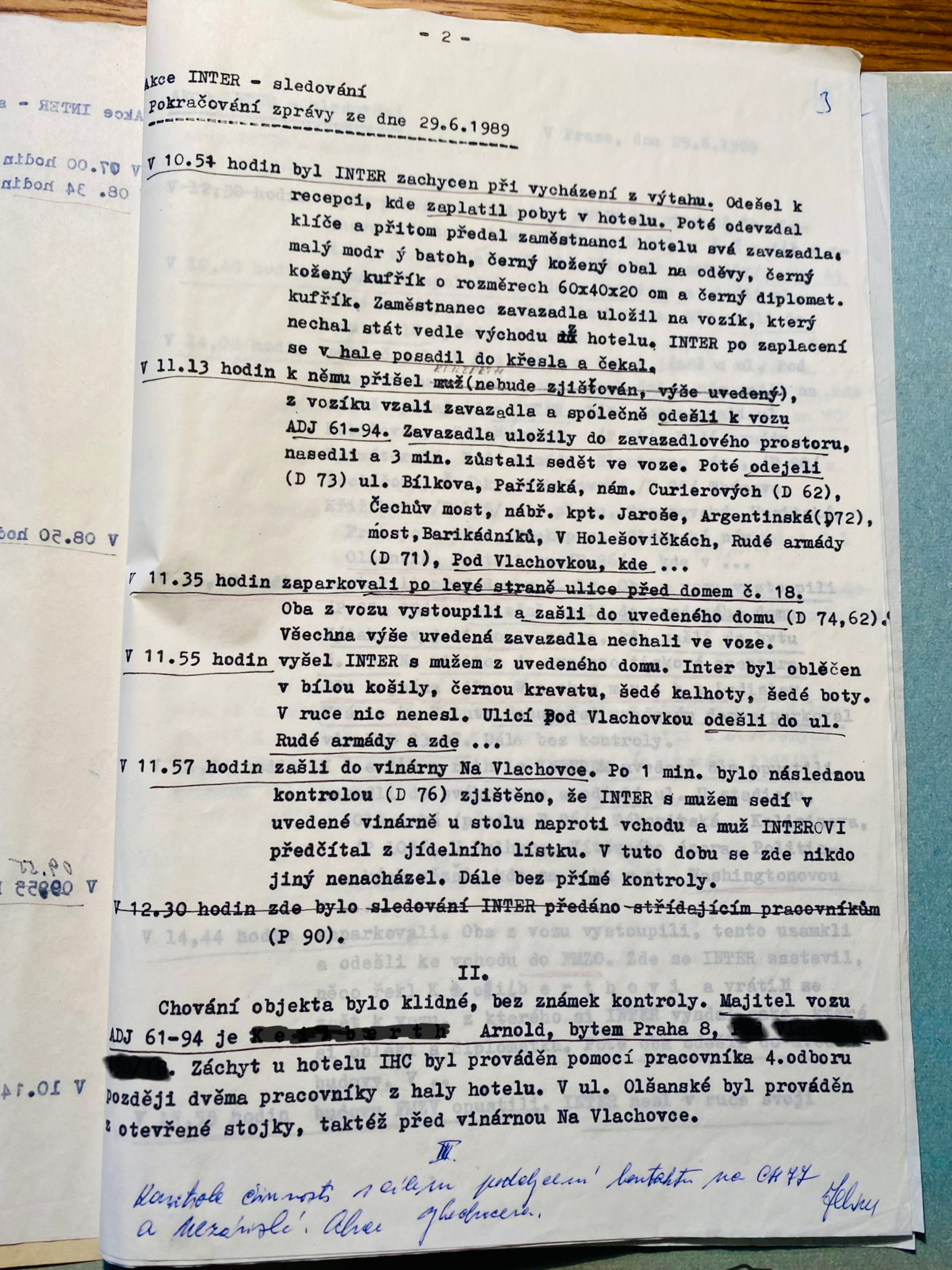
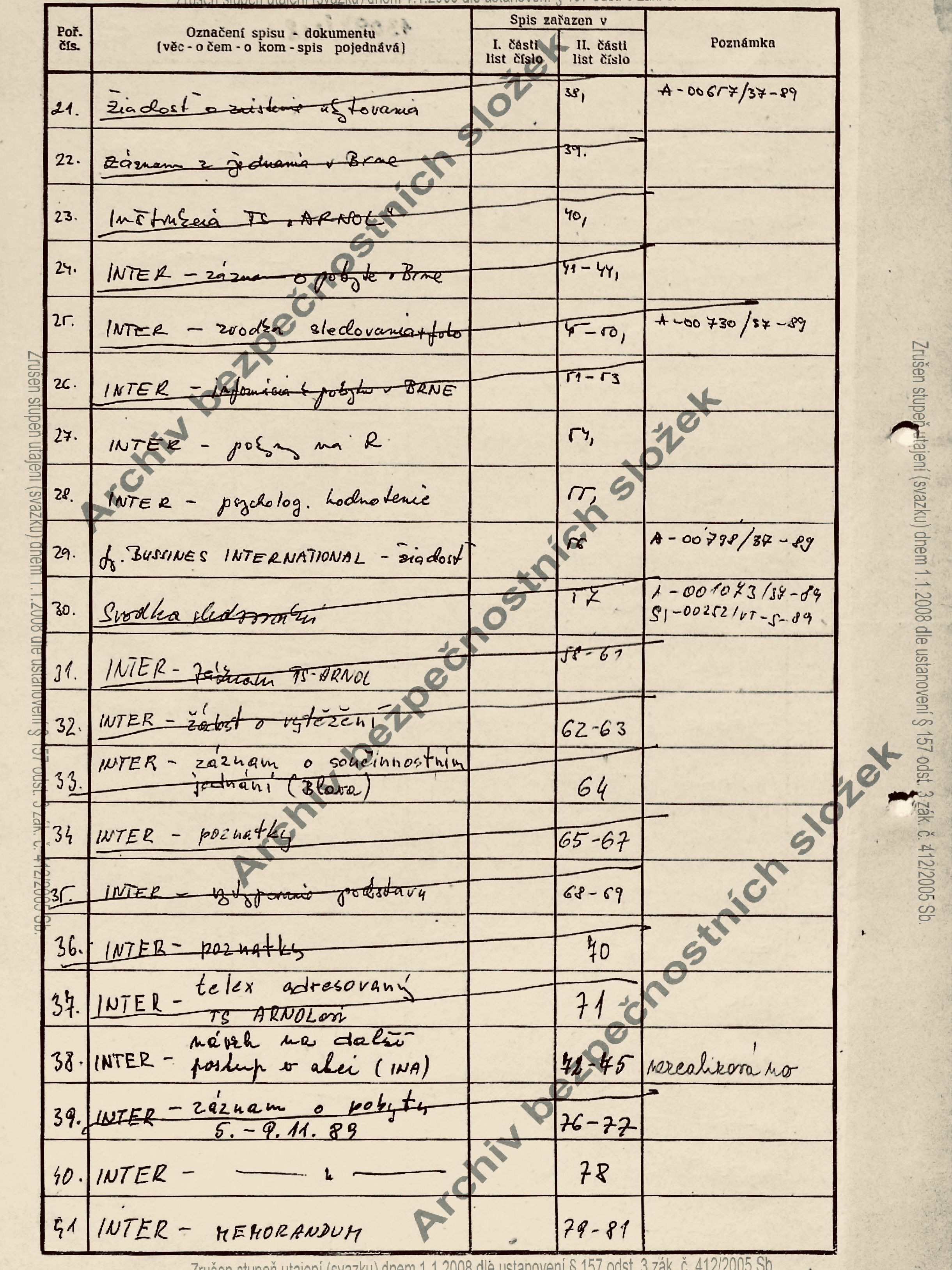
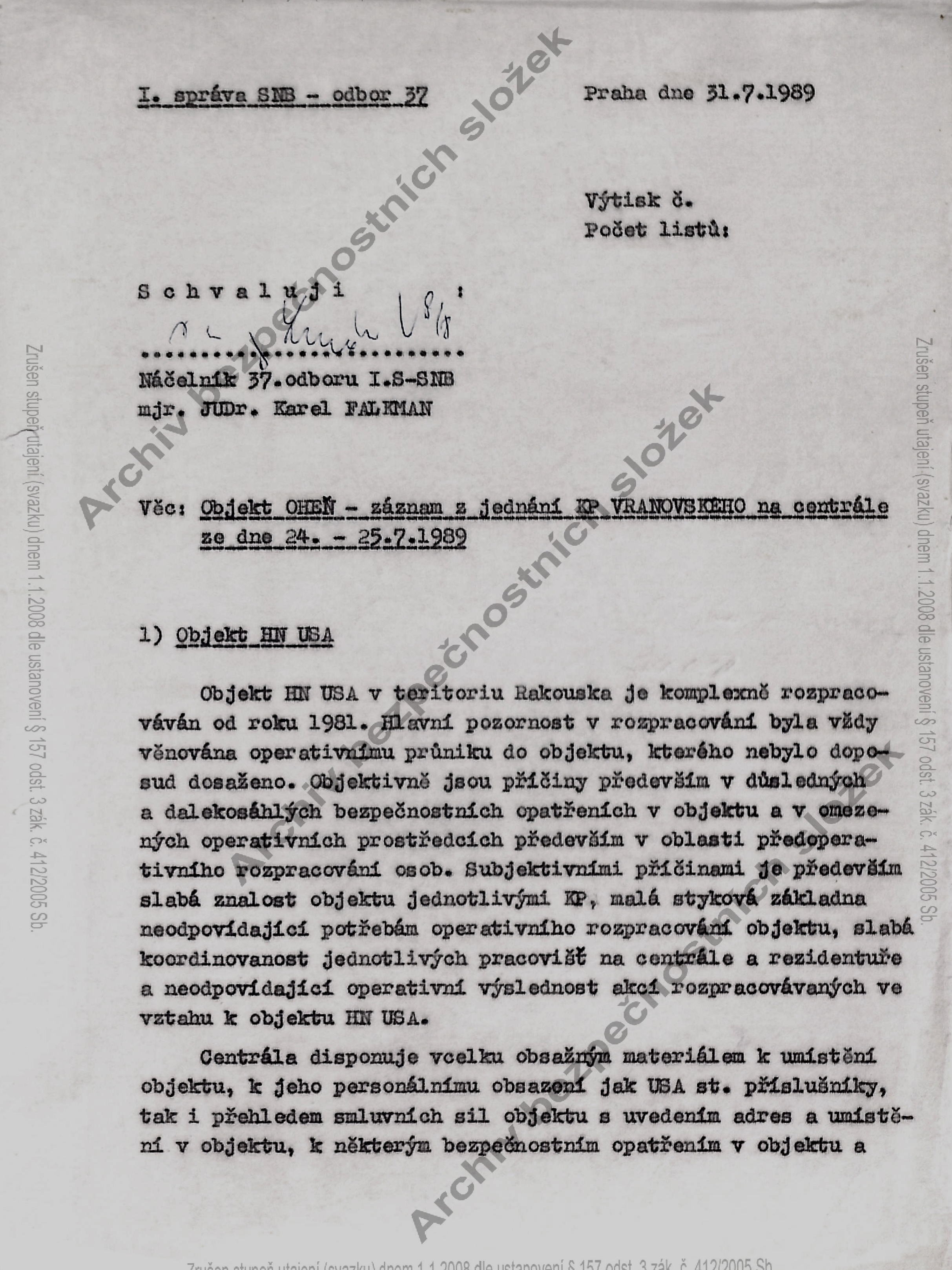
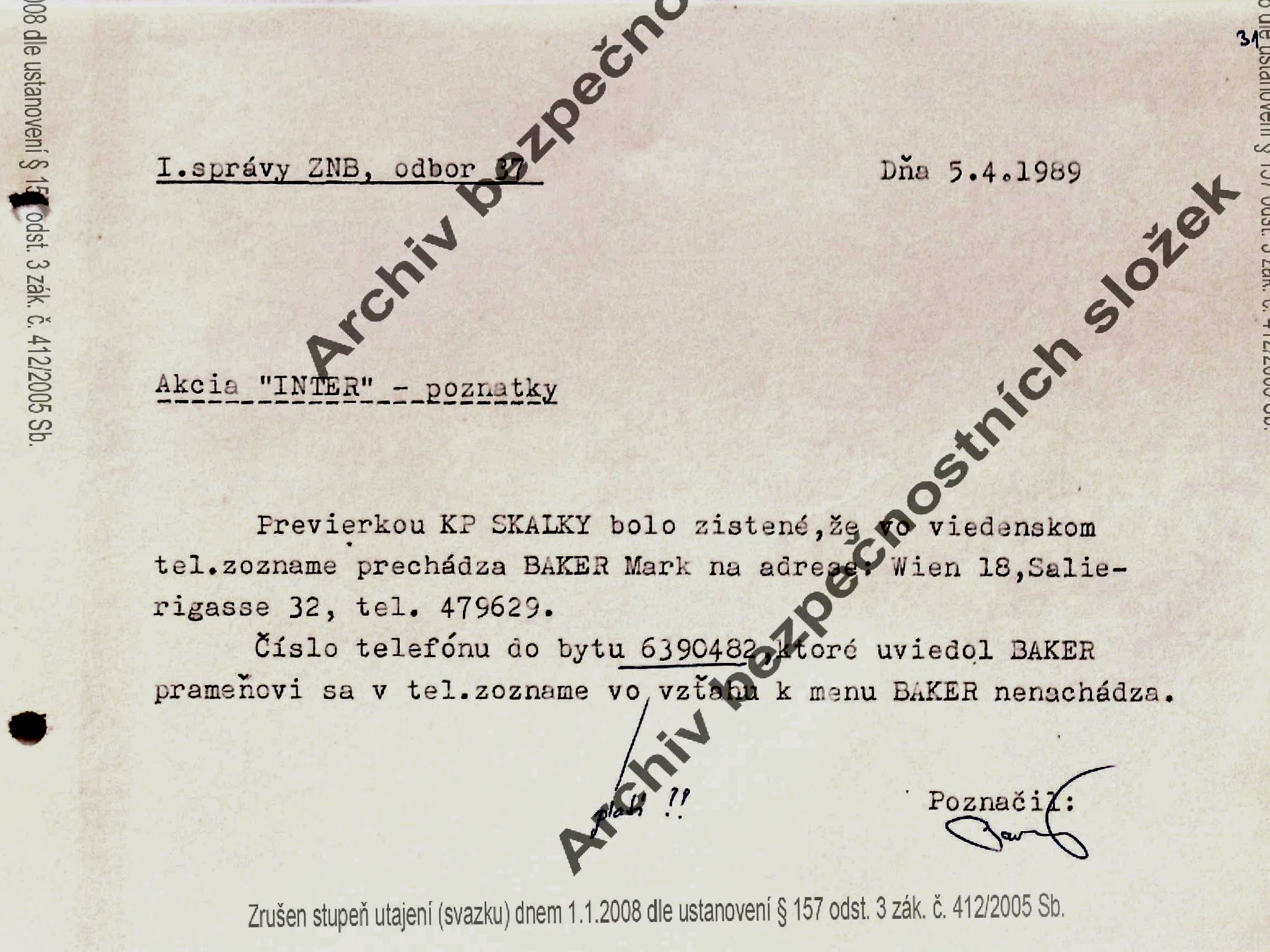

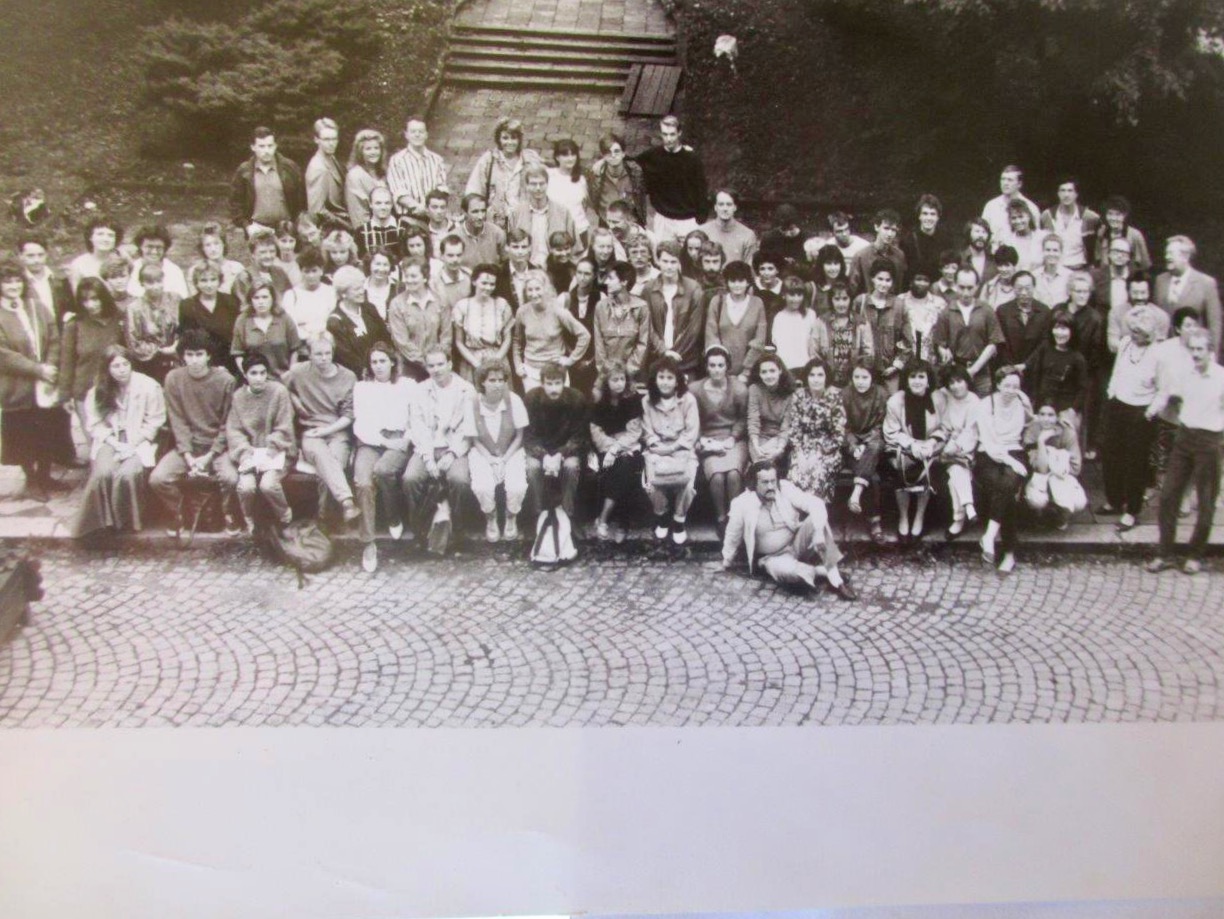
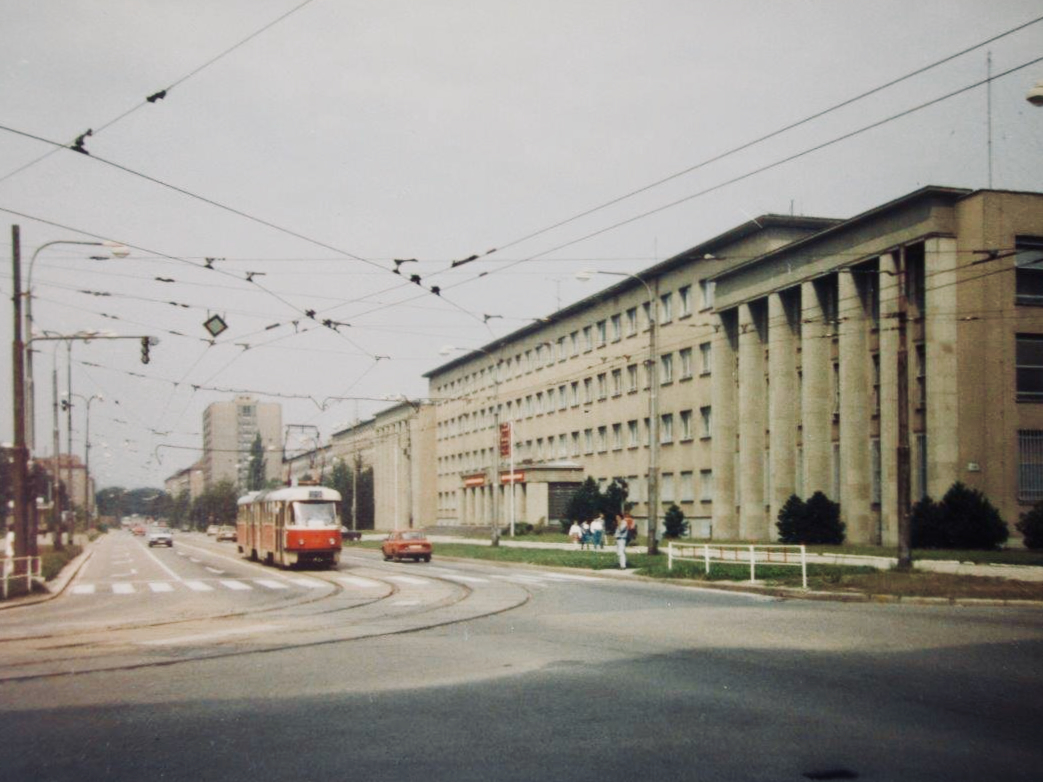

That’s a real screenplay! Like a James Bond in Brno or Indiana Jones in P?íkopy.
Great story, indeed. Thank you for pointing out this part of our (not-so-great) history
BTW: There are Czech grammatical errors, mistakes in the StB documents – they were good spies, but not a good writers 🙂
Happy you liked the story and thanks for leaving a comment. Mark
This is absolutely fascinating! I came across your site as my grandfather also had a file from 1956 although he was by then a naturalised British citizen living in Lancashire. I’m trying to access the file but probably need a researcher to do it. I’m going to check out your other posts. Thank you!
Thank you for your comment. If you are interested in learning more about your grandfather, write me an email and I can put you in touch with people here in Prague who may be able to help you find his file. Best, Mark